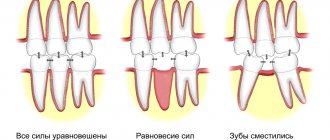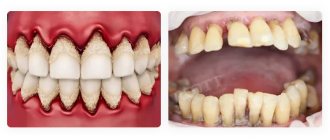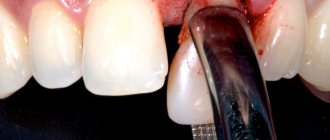A beautiful smile undoubtedly matters to a person. After all, this is what many people fix their attention on when they meet. A smile leaves an unforgettable impression on the interlocutor. It plays an important role in your confidence when communicating. A beautiful smile will improve contact with your interlocutor, improve behavior and leave behind all sorrows and self-doubt, and will also melt the heart of any stranger. But if the smile is not perfect and there is a defect in the front teeth (cracked dental plate, extracted tooth, crooked bite or tooth fragment, caries), how can we talk about self-confidence? Such a person will become isolated from others, become withdrawn, stop smiling, and will feel awkward when communicating. All this can leave a mark on a person’s profession and on his personal life.
No one wants to show problems with their front teeth to others, so dentures are the best solution for such patients.
When performing prosthetics after removal, it is important to restore and preserve the functions of the organ:
- Correct bite;
- Shape;
- Natural color;
- Gum health.
Prosthetics of the front teeth is also an aesthetic issue, therefore, to create a beautiful smile, it is necessary to use high-quality, durable materials that will visually look good. In dentistry, several methods of installing dentures are used and leading materials are used to give each patient a dazzling smile.
The main indications for the use of anterior dental prostheses are:
- Cracks in the dental plate, chips, broken teeth;
- Lost teeth or congenital adentia;
- Carious teeth;
- Crooked bite;
- Yellowing or darkening of the enamel;
- Crooked teeth, irregular shape and uneven “facial” surface of the tooth;
- Early unsuccessful prosthetics.
To solve your problem and select the correct method for installing dentures after removing your front teeth, you can consult the Dr. Levin dental clinic by calling the clinic.
Prosthetic options for anterior teeth
- Temporary and permanent;
- Removable and non-removable.
Temporary prostheses are needed for emergency filling of the defect. This option is performed for a broken tooth, extraction, and when removing or replacing other dentures. To do this, temporary plastic prostheses or removable dentures are used to close the existing defect. The wearing period of such implants is 30-60 days. This time will be enough to make a permanent prosthesis and sanitize the oral cavity.
Permanent prosthetics are performed after the root implant has healed, with healthy neighboring teeth, and in the absence of inflammatory changes in the oral cavity.
Removable prosthetics can be used in people who, due to contraindications, cannot currently perform such a procedure and it is postponed for some time. Or when it is not possible to install a prosthetic bridge due to the lack of more than four teeth in a row or the supporting teeth are damaged. Such patients are recommended to wear removable dentures.
Fixed prosthetics are carried out according to indications and include the following techniques:
- Implantation;
- Bridge prosthetics;
- Installation of crowns;
- Installation of veneers or lumineers.
There are several options for prosthetics of the upper and lower front teeth
Missing one or more teeth
In case of partial absence of teeth, bridges supported by natural teeth, clasp dentures (on an arch), partial removable dentures, and, a good option, prosthetics on implants with single crowns or bridge structures are considered.
In the absence of all teeth in the upper jaw, a complete removable denture, prosthetics on implants (using single crowns or a bridge structure), covering prosthetics on mini-implants, and dentures on implants with a beam fastening, for example, All-on-4, are used.
The absence of one or more teeth is one of the most common reasons for visiting a dentist.
Implantation of artificial teeth
A modern, long-lasting option for the restoration of front teeth is implantation. This operation involves inserting a special pin into the jaw bone, in the place where a tooth is missing, which will act as a tooth root and will counteract atrophic changes in bone tissue. This pin is made of titanium and does not cause any inconvenience or complications in the future. Then a crown made of ceramic is installed on this titanium rod. Implantation makes it possible not to touch the healthy teeth in the neighborhood. For this procedure, high-quality durable implants from the Nobel Biocare brand are used, which are guaranteed for life. The implanted tooth will not differ in any way from the rest, since the crown is made after measurement and exactly matches the shape and natural shade of the teeth. Another technique for using dentures on the front teeth is installing a bridge.
The name “bridge” was borrowed from technicians, since its installation uses the principle of constructing bridges. A bridge is a type of permanent dental prosthesis; they are used to replace defects of several teeth (up to four) in a row. To do this, special crowns are installed on the adjacent good teeth, between which the prosthesis will be placed. The negative quality of this technique is the need to grind down the surface and remove the pulp of healthy teeth on which crowns will be placed. The bridge also needs to be replaced at least once every few years. But with these disadvantages, this method allows you to avoid surgical intervention.
What are the advantages of a ceramic crown?
Today, ceramic dental crowns are the most aesthetically pleasing orthopedic structures installed both in the smile area and on chewing teeth. Ceramics is biologically inert and indifferent, is not perceived by the body as something foreign, does not absorb foreign odors, pigments and bacteria, does not emit harmful substances, and is also very durable. High-quality dentures cannot be distinguished from natural teeth.
3 main advantages of ceramic crowns
- Superior Aesthetics
- Hypoallergenic
- Reliability
Prosthetics of anterior teeth using crowns
Sometimes lesions on the front teeth can be more serious. Then prosthetics of the front teeth using crowns is suitable. To make the most natural shape of the tooth being installed and to ensure a tight fit of the crown, it is necessary to grind the affected tooth and, if necessary, remove the pulp and nerve. Then process and seal the canals. After fitting, a ceramic crown is installed on the dental cement mortar. Ceramic or zirconium structures without metal are best suited for dental prosthetics.
The main advantages of such crowns are:
- The base from which the dentures are made must be hypoallergenic. Which is very important. Ceramic crowns do not cause allergic reactions.
- Ceramic crowns look aesthetically pleasing. Based on individual measurements and subsequent fitting, you can ideally select the desired shape and color that will match the natural shade of natural teeth.
- Metal-free crowns do not cause darkening of the gums around the installed tooth and do not leave a metal rim. They also do not lead to alveolitis, gingivitis and periodontitis.
- Ceramic crowns will not cause discomfort when eating food at different temperatures.
- Also, such crowns are lightweight, comfortable and durable.
Repair procedures for a metal-ceramic tooth crown
A common problem that patients present with is the occurrence of chips on their dentures. The restoration procedure depends on the size of the defect and how deep it is. Common cases are as follows:
- small nicks are removed quickly. The dentist polishes the chipped edges, processes them, and this completes the procedure;
- a medium to large nick, if the metal frame is not affected, requires restoration of the ceramic layer. The specialist uses a gel composite to restore the ceramics, selected by color. Polishing and grinding are carried out;
- in cases where the metal layer is exposed, the application of a metal frame is required. Opaque is applied, after which the ceramic layer is restored;
- cracks in the metal frame of the crown require complete replacement.
Metal-ceramic crowns are considered the most popular type of prosthetics. If you visit the dentist once every six months and take proper care of your oral cavity, the life of the crowns will be long, without the occurrence of defects.
The price of such a metal-ceramic crown directly depends on many components: the cost of the metal alloy from which the frame is made, the cost of the ceramic layer, payment for the work of the dentist, dental technician, patient characteristics, and the cost of additional services. Therefore, the cost is calculated for each case individually.
Prosthetic replacement of anterior tooth after extraction
After tooth extraction, it is better to do its prosthetics using the express implantation technique, in the absence of contraindications. To do this, immediately after tooth extraction, an implant and a special abutment are installed in its alveolar socket to form the correct gum shape. A crown is temporarily placed on it. After the implant has healed for approximately several months, a permanent crown is installed.
The advantages of express implantation include:
- This procedure does not require any additional incisions, which is less traumatic to the gums;
- The implant is installed in an open manner, which also does not require additional surgical intervention;
- This method is perfect for patients who do not want to wait until the hole heals and a bridge or crown can be installed.
- Short healing period;
- There are few side complications that are unpleasant for the patient.
Content:
- Features of metal-ceramic crowns per tooth
- The need to install a metal-ceramic crown on a tooth
- The procedure for manufacturing metal-ceramic structures for teeth
- The procedure for installing a metal-ceramic crown on a tooth
- Rules for caring for metal-ceramic crowns
- Repair procedures for metal-ceramic crowns on teeth
A metal-ceramic tooth crown consists of two parts: metal and ceramic, respectively. Unhealthy teeth cause great discomfort and require the help of a specialist. When it is impossible to restore the original shape of teeth for a long time by filling, doctors suggest installing crowns. Metal-ceramic products are the best option for restoring teeth. The first layer is metal, it is responsible for the chewing function; ceramics are thinly applied to it. This coating does not cause allergic reactions, so it is suitable for most patients. The procedure is carried out by highly qualified specialists with experience. The quality of work on installing a crown on a metal-ceramic tooth is ensured by modern equipment and original materials.
Installation of dentures for anterior teeth without turning
This is the restoration of damaged teeth, when the neighboring teeth intended for support are not ground down or depulped. In this case, it is worth performing implantation. This is one of the most gentle and atraumatic methods of installing upper and lower teeth. The essence of the method is that in the place of the lost tooth, an implant is installed in the jaw bone tissue, which performs the function of a root. Subsequently, a crown is put on it.
There are also methods that do not require grinding of a layer of healthy teeth, but they are rather temporary.
Restoration of ceramic crowns
Despite the strength of modern ceramic dentures, the query “The ceramic has broken off from the crown, what should I do?” found on the Internet quite often. Typically a defect occurs for the following reasons:
- injury - blow or fall;
- defects in the work of a dental technician;
- malocclusion, bruxism;
- strong mechanical impact on the structure during chewing.
There are two possible solutions to the problem - replacement and restoration.
- Replacement of prosthesis. The crown is removed from the mouth, and the entire prosthetic process is repeated from the moment the impressions are taken until the new structure is attached.
- Restoration. The chip on the ceramic crown is polished to the optimal shape, and a light-curing composite material is placed into the cavity. After hardening, the specialist models the coating, forms bumps and fissures, and grinds uneven edges to the desired size.
The advantages of repair are short time and low cost; chipped ceramics on the crown can be restored in an hour in the dentist’s chair. However, even the use of the most modern materials does not provide the quality that is obtained when making a prosthesis “from scratch” in a dental laboratory. If the cause of the chip was carelessness when chewing hard food, after repair the denture will last for many years. Malocclusions and other pathologies of the dental system reduce the service life of the restored crown several times.
Veneers and Lumineers
Veneers and lumineers can be used as aesthetic options for dentures on the front teeth. Veneers are very thin shells of porcelain that are given a color similar to the natural color of the patient's teeth. Veneers completely match the shape of a natural tooth. Such plates are attached to the front surface of the tooth.
Lumineers are transparent and very thin plates about 0.15 mm thick. Placed on the front surface of the tooth. This cosmetic procedure is non-invasive, quick, painless and long lasting.
These qualities determine the indications for the installation of veneers or lumineers:
- Crack and small chip of a tooth;
- Yellowing or darkening of tooth enamel;
- Uneven frontal surface;
- Crooked teeth.
Stages of prosthetics
- Preparation
- assess the general condition of the oral cavity, take an x-ray, carry out hygienic cleaning (removal of plaque, tartar), treat caries, gums, change old fillings. - Preparation
- the front tooth is ground down for a crown, the stump is given the desired shape. According to indications, depulpation, treatment, and filling of dental canals are carried out. In case of severe destruction of the supragingival part, the root is strengthened with a stump insert. The prepared support is covered with a temporary plastic structure to protect tissues from destruction, chemical and temperature irritants. - Taking impressions
– the doctor takes impressions of the patient’s teeth using an impression tray with impression material or a digital scanner. The obtained data is transmitted to the dental laboratory. - Making a crown
- based on models, an orthopedic system is created in the laboratory using casting, pressing, and milling. At the manufacturing stage, the model is tried on the patient, and adjustments are made if necessary. - Installation
- the finished crown is fixed to the support with dental cement. The crown on the front tooth implant is installed using a cement or screw method.
Installation of prosthetic anterior teeth on the upper and lower jaws
The use of dentures for the lower and upper anterior teeth is almost the same from a practical point of view. The difference may lie in the fact that the installation of dentures for the upper teeth requires more attention from the dentist, since the upper jaw is somewhat less well supplied with blood than the lower jaw, hence healing here will take a little longer. And also, when a person smiles, the front teeth are the first to be seen from above, so it is necessary to pay more attention to the aesthetic side of prosthetics.
What is the service life of a ceramic crown?
Metal-ceramic crowns are fixed with dental cement, which breaks down after about 5 to 7 years. However, ceramic dentures are attached to a particularly strong adhesive material, which increases their service life to 10 years.
As for strength, ceramic crowns can easily withstand the required chewing load. If a ceramic crown chips for some reason, it can be easily restored. Since the metal-free structure does not have a frame, almost any minor damage to it will be invisible. If more or less serious damage occurs, the all-ceramic crown can simply be polished.
Photos before and after installation of ceramic crowns at the Research Center. Works by Karneev A.N.
Preparing for dental prosthetics
Many people do not like any dental procedures, and this is due to the fear of unbearable pain. You should not be afraid of dental prosthetics, since the most unpleasant thing you will encounter is tooth grinding and depulpation. And all procedures are carried out using local, good, strong anesthetics.
An important diagnostic point is x-ray examination to determine the number and size of roots.
Other stages of preparation include the improvement of neighboring teeth (removal of plaque, treatment of carious damage), which will serve as a support for the prosthesis. If the tooth is significantly damaged, they resort to extraction, treatment of the canals and their subsequent filling.
For prosthetic treatment of anterior teeth, as for any other manipulation, there are contraindications. They are divided into absolute and relative.
Absolute contraindications include:
- 3-4 stages of cancer;
- Conditions after chemotherapy;
- Immunodeficiency conditions;
- Severe somatic diseases in the stage of decompensated state;
Relative:
- Diabetes mellitus (especially type 1);
- Diseases of the heart and blood vessels, such as hypertension with crisis and angina pectoris;
- Smoking, alcoholism;
- Mental disorders;
- Pregnancy;
- Allergic reactions to dental medications and materials.
What types of ceramic crowns are there?
Pressed ceramic crown
The most advanced type is the pressed ceramic crown. The design is highly durable, more accurately reproduces the color of natural teeth, and to install the prosthesis there is no need for strong grinding of the teeth, as is required for fixing structures made from other materials. The last advantage is extremely important, since the service life of the prosthesis depends on the amount of preserved natural dental tissue.
The most famous types of dentures made of pressed ceramics are created using E-max and Empress technologies.
- The E-max ceramic crown is made of lithium disilicate, that is, glass ceramics, which has a high degree of strength and is ideal for prosthetics in both the anterior and chewing regions.
- The Empress ceramic crown is made from the same material, but with the addition of leucite crystals, a mineral of igneous origin. The structures have excellent aesthetic characteristics, but are not able to withstand heavy loads, so they are installed only in the smile area.
Ceramic zirconium crowns
Often, prostheses made of zirconium are classified as metal-free ceramic crowns, which is fundamentally incorrect. Zirconium dioxide is the same metal, only white. Unlike ceramics, it does not have sufficient transparency, and its color palette is very limited. But, on the other hand, this material has good strength. Which crowns are better – ceramic or zirconium? Zirconium dioxide ceramic crowns are more suitable for restoring chewing teeth. In the frontal section, preference should be given to designs made of metal-free ceramics.
Ceramic crowns on a zirconium dioxide frame
A crown on a zirconium base, coated with a layer of ceramics, is the latest development in prosthetics. The white material, unlike metal, does not shine through the porcelain shell, which allows you to achieve excellent aesthetic results with high strength and wear resistance of the structure. In addition, the biocompatibility of a ceramic crown on a zirconium frame eliminates the risk of allergies and periodontal inflammation.
Why are complex teeth treated at PARTNER-MED?
We know how to work!
We have orthopedic dentists with 8-30 years of experience!
We love to work!
We will give you a free consultation and tell you exactly how best to make your teeth better!
We are responsible for the result!
We work conscientiously and will make your teeth LIKE YOURSELF!
Request a call back or dial our number!
+7
This phone call does not obligate you to anything. Just give us a chance and we will help you!
Just pick up the phone and call us!
+7
We will definitely make you an offer that you cannot refuse!
Advantages of the RUTT clinic and cost
At ROOTT clinics in Moscow, located at Butyrskaya and Proletarskaya metro stations, you will receive:
- full objective consultation on prosthetic methods;
- guarantee for all types of dentures for the upper jaw installed by us;
- comfortable restoration of chewing or frontal rows.
The cost of restoration depends on the specific clinical case: the number of missing teeth, the chosen design, material and work of specialists. You can find out more about the cost of an upper jaw denture by phone or at a free consultation with a specialist.
Manufacturing of removable dentures
The main steps in the manufacture of upper removable dentures are as follows. They may vary slightly depending on the type and material chosen, but we will consider the removable option:
- an impression is taken, on the basis of which a wax model of the jaw is made;
- a plaster prosthesis is cast in the articulator;
- fitting takes place in the patient’s mouth;
- in the laboratory, the technician makes the final version - a metal frame with bases and crowns made of the selected material and color;
- fitting, fitting in the office, fixation. On average, the work takes up to 2 weeks.
Article Expert
Pak Roman Vladimirovich Dentist-orthopedist, doctor of the highest category
Work experience: more than 30 years











